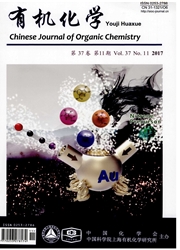

 中文摘要:
中文摘要:
通过文献报道的方法,高效合成了大环化合物环[2](2,6-二(1H-咪唑基)吡啶[2](1,4-二亚甲基苯)(14+)和环[2](2,6-二(1H-咪唑基)吡啶[2](1,2-二亚甲基苯)(24+).通过溶液中核磁1H谱、气相电喷雾电离质谱(ESI-MS)及固相单晶衍射方法,详细考察了这两个大环主体化合物与一系列体积较小、形状各异的无机阴离子客体间的相互作用.Job’s plot研究结果表明与24+相比,大环主体14+能够结合等量或者更多的阴离子客体;结合常数的计算表明,对于易于形成分子间氢键与大环主体进行复合的阴离子即Cl-,3N-,3NO-或4HSO-,24+与该类阴离子进行1∶1复合的结合常数(Ka1)总是大于甚至是远大于14+.但是对于较难形成分子间氢键,随着离子半径的增大导致极化性增强,更易于发生anion-π作用的离子如Br-和I-,14+与它们的结合常数近于甚至大于24+.推测产生上述现象的原因是由于24+具有紧凑的骨架结构,使四个酸性较强的咪唑盐基2位C—H位点能够有效协同,与体积较小的阴离子同时形成强的分子间氢键;而14+的骨架结构使得上述位点的空间距离较大,具有咪唑盐基团2位C—H键难以全部参与对阴离子的相互作用,而更易于同时与更多的阴离子结合,并更易于发生anion-π的协同作用.上述结果展示了大环主体化合物的骨架结构将控制其空腔的大小、形状及与客体阴离子产生分子间氢键相互作用的C—H键位点的空间分布,从而极大地影响主客体之间复合的模式(如化学计量比和结合常数等).
 英文摘要:
英文摘要:
Two novel macrocycle hosts with flexible frameworks and cavities, cyclo[2](2,6-di(1H-imidazol-1-yl)pyridine)[2] (1,4-dimethylenebenzene) (14+) and cyclo[2](2,6-di(1H-imidazol-1-yl)pyridine)[2](1,2-dimethylenebenzene) (24+), were syn-thesized with high yields via cyclization reactions between 2,6-di(1H-imidazol-1-yl)pyridine and 1,4-bisbromomethyl benzene or 1,2-bisbromomethyl-benzene. Herein, the interactions between 14+ or 24+ and a series of inorganic anionic guests were studied in detail via the following methods:(1) 1H NMR spectroscopy in d6-DMSO solution;(2) electrospray ionization mass spectrometry (ESI-MS) in gas phase;(3) single crystal X-ray crystallography in solid state. It is noted that the anionic guest species has different shapes, namely anions with ball shapes like Cl-, Br-, I-;linear anion N3-;triangle NO3- or tetrahedron HSO4-. The study found that 14+ can bind more small inorganic anion species than macrocycle 24+. In addition, the result implied that when the inorganic anion guest acts as strong intermolecular hydrogen bond acceptor (i.e. anionic guest (A-) such as Cl-, N3-, NO3- or 4HSO-), the associate constant (Ka) maintains Ka[24+·A-]3+>Ka[14+·A-]3+; on the contrary, when anionic guest A- (Br- or I-) is hard to form intermolecular hydrogen bonds but easy contribute to anion-π interaction, the association constants of the 1∶1 (host:guest) complexes follow another trend (i.e. Ka[24+·A-]3+
 同期刊论文项目
同期刊论文项目
 同项目期刊论文
同项目期刊论文
 The complexation between ‘Texas sized’ molecular box and linear n-aliphate dianion: en route to supr
The complexation between ‘Texas sized’ molecular box and linear n-aliphate dianion: en route to supr 期刊信息
期刊信息
